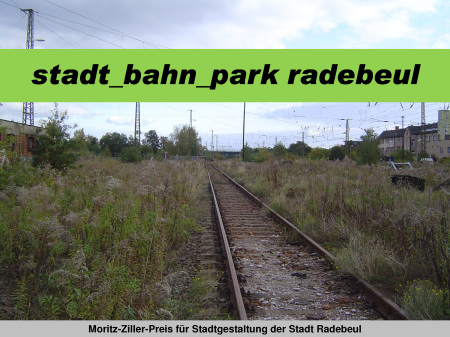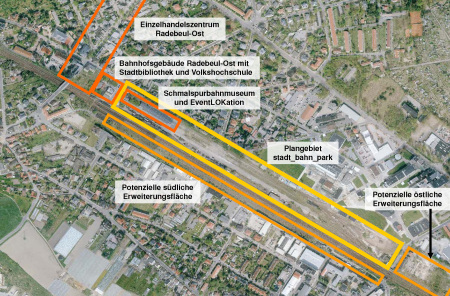city_railway_park radebeul
Competition theme 2010/2011
This year's competition theme "stadt_bahn_park" was selected from several proposed themes by the expert panel of trustees consisting of representatives from universities and professional associations as well as the city administration. The competition area is a former railway site in the eastern part of the city, which separates two urban areas as a caesura. The neighbouring eastern city centre with the town hall site is developing very positively as part of an urban redevelopment area. The directly neighbouring railway station area is being developed as an attractive cultural, museum and shopping quarter.

© Stadtverwaltung Radebeul
The aim is to reclaim and design the area as an urban space with a variety of functions and links to the surrounding urban areas. We are looking for viable ideas for the design of the competition area and its integration into the urban environment. They should contribute to the future-orientated and sustainable strengthening of the city of Radebeul. Additional impetus is expected to be generated through the impact and links to the surrounding area. The needs and wishes of neighbours and residents as well as local stakeholders must be taken into account when considering the concept.
Competition area 2010/2011
The competition area is located in the eastern part of the city on the border with the neighbouring city of Dresden. It is an inner-city area bordered to the north and south by densely built-up residential and commercial areas. The area is enclosed between a Wilhelminian-style residential area to the north, the busy four-track mainline, regional and freight railway line of Deutsche Bahn and the track and functional facilities of the historic narrow-gauge railway to the south and east, a former administration and storage building converted into a narrow-gauge railway museum and event space, and the former railway station building to the west. The latter houses the municipal library and, in future, the adult education centre, as it is no longer required for the operation of the Radebeul-Ost railway station.

© Stadtverwaltung Radebeul
The competition area borders on the eastern city centre, which is characterised by the Hauptstraße shopping street, the administrative location with the town hall and technical town hall as well as a school location with a primary school and a grammar school. The redevelopment area "Zentrum und Dorfkern Radebeul-Ost", formally established in 2003, also borders the competition area to the west. The areas of the former goods station in Radebeul-Ost have lost their function as such and lie fallow. Formerly used as a loading station with a siding on the Leipzig-Dresden railway line, today only the already renovated warehouse and administration building and the still existing and to be maintained siding for a neighbouring pharmaceutical and chemical plant to the north bear witness to its original use. The area is crossed in an east-west direction by a paved road that serves to access the tracks and functional buildings of the narrow-gauge railway, which lie parallel to the tracks of the Deutsche Bahn. Over the years, ruderal flora of low ecological value has developed in natural succession following the dismantling of tracks north of the access road that are no longer required. There are numerous large-crowned and ecologically valuable trees along Sidonienstraße, which runs north of the area. These should be preserved. There is a jump in the terrain between the competition area and Sidonienstraße, which is currently intercepted by an embankment or a wall. Potential expansion areas border the competition area to the east and south. These are spatially separated from the competition area by Forststrasse and the Deutsche Bahn railway line, but are fundamentally suitable for an expansion of space and use in connection with the competition area. Ideas for future uses in connection with the ideas developed for the core area of the competition site are expected. Current plans by the city of Radebeul and a private investor include the redesign of the neighbouring railway station area to the west and the construction of a food market as well as the renovation of the listed corner building on Hauptstraße/Sidonienstraße. This will give the eastern city centre an attractive southern end by upgrading the station area. Furthermore, the owner of the narrow-gauge railway museum is planning to expand the current museum use and design the outdoor areas in the medium term. The aim of combining the existing uses and projects that are already in the immediate pipeline is to establish an art and culture quarter with positive spillover effects into the neighbouring urban areas and beyond the city limits.
Expert jury 2010/2011
An independent and high-calibre jury will select the best competition entry, the author of which will be awarded the Moritz Ziller Prize for Urban Design in the amount of 2,500 euros and a prize sculpture. The winner will be honoured at a ceremony on the Day of Architecture 2011. The results of the competition will be documented in an exhibition and a brochure.
Specialist judges
The 2011 jury appointed by the organiser is composed as follows:
| Prof Dr Engelbert Lütke-Daldrup (Chairman) | AfS Agency for Urban Development GmbH, Berlin |
| Prof Thomas Knerer | Knerer und Lang Architekten GmbH, Dresden |
| Prof. Hermann Kokenge | kokenge.ritter gmbh Landscape Architecture, Dresden |
| Till Rehwaldt | Rehwaldt Landscape Architects, Dresden |
| Prof. Dr Iris Reuther | Office for Urban Projects, Leipzig |
| Oliver Stolzenberg (permanently present deputy expert judge) | Architect, Dresden |
Judges (in an advisory capacity)
| Thomas Joachim | Managing Director M+E Consult GmbH |
| Dr Jörg Müller | First Mayor of the City of Radebeul |
| Dr Helmut Schickaneder | Managing Director Arevipharma GmbH |
| Birko Teichmann | Authorised signatory DB Services Immobilien GmbH |
Moritz Ziller Prize award ceremony on 25 June 2011
The first Moritz Ziller Prize was awarded in a festive setting on 25 June 2011. After numerous visitors had informed themselves about the 67 competition entries in the exhibition, the actual award ceremony was opened by young musicians from the Meißen district music school. The subsequent presentations not only provided detailed information about the competition, but also paid tribute to the creation of the prize sculpture and used international examples to illustrate the broad topic of central railway areas in the context of inner-city urban densification and the further development of cities. The highlight was the recognition of the award-winning competition entries by Prof. Lütke Daldrup and the presentation of the prize sculpture to the 1st prize winner Andreas Rodemann by the Mayor of Radebeul, Bert Wendsche.
© Stadtverwaltung Radebeul
© Stadtverwaltung Radebeul
Award winners 2010/2011
Prize winner (030)
Andreas Rodemann, Zittau
© Andreas Rodemann
The author is building over parts of the brownfield site and the neighbouring railway facilities with frame-like bridges on which containers are to be placed for various purposes. The associated idea of offering inexpensive and flexibly usable space in an interesting location for "start-up" companies seems convincing, even if this measure is likely to be very costly due to the installation of the containers on bridges. The authors provide little information on the open spaces, but the existing and planned uses of the narrow-gauge railway museum and the railway will not be significantly impaired by the installation of the bridges. The concept is characterised by a high degree of originality and symbolism. It is quite conceivable that this will create the necessary attractiveness to fill the new structures with life. The temporary nature of the buildings leaves the way open for further developments in the future.
Download prize-winning work by Andreas Rodemann
Recognised for their work were:
Brochure
The brochure contains all the information about the competition, including documentation of the celebratory event. From the idea of organising an urban planning competition to the description of the competition area and the jury and jury meeting, the most important stages are described. In the second part of the brochure, all 67 competition entries are presented in detail with a text and a section of the site plan.


